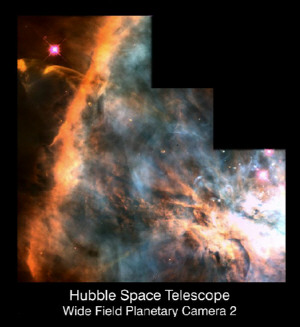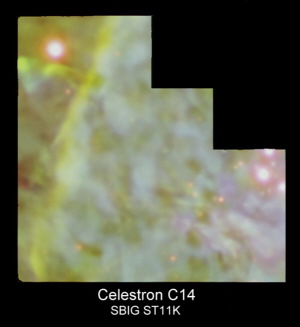

This is one of the nearest regions of very recent star formation (300,000 years ago). The nebula is a giant gas cloud illuminated by the brightest of the young hot stars at the top of the picture. Many of the fainter young stars are surrounded by disks of dust and gas that are slightly more than twice the diameter of the Solar System.
The great plume of gas in the lower left in this picture is the result of the ejection of material from a recently formed star.
The brightest portions are "hills" on the surface of the nebula, and the long bright bar is where Earth observers look along a long "wall" on a gaseous surface. The diagonal length of the image is 1.6 light-years. Red light depicts emission in Nitrogen; green is Hydrogen; and blue is Oxygen.
The Orion Nebula star-birth region is 1,500 light-years away, in the direction of the constellation Orion the Hunter.
A Native resolution close-up of the same region to the left taken with my C14 and ST11K in the light of Sulfur-II (Red Channel), Hydrogen Alpha (Green Channel) and Oxygen-III (Blue Channel).
Many of the same items are visible in both images, but both atmosphere and aperature have thwarted my attempts of Hubble-Like images from my backyard (rather Astro-Ranch).
Note that the difference in colors is due to using a Sulphur II filter rather than a Nitrogen filter for the Red Channel.


These four massive energetic stars are seen with a number of evaporating proto-planetary disks.
The palette used for this image is mapped color with
SEDS Messier Catalog Hubble Images of the Trapezium Cluster in the Orion Nebula M42
